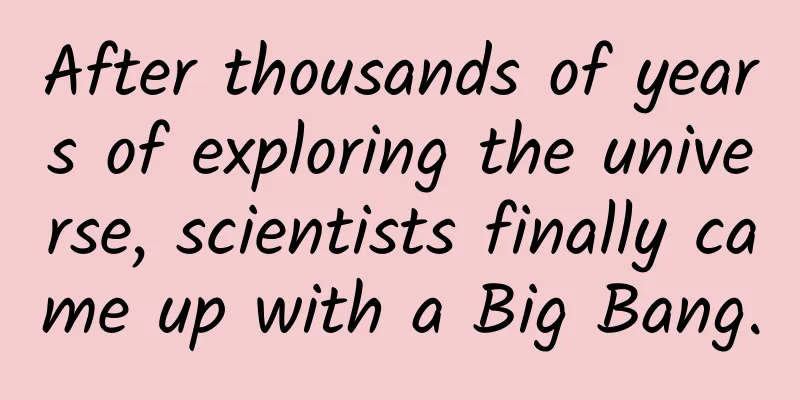After thousands of years of exploring the universe, scientists finally came up with a Big Bang.

|
Introduction: Modern astronomy believes that the universe we live in was born from a big bang, and 13.8 billion years after the explosion, our universe is still expanding. How did astronomers determine that the universe originated from the big bang? How did they discover that the universe is expanding? Many distant galaxies are captured in this image from the Hubble Space Telescope, some of which formed just 600 million years after the Big Bang. We know that the universe is the sum of all time, space and all celestial bodies, including our Earth. The universe is so huge that we humans are just tiny creatures living in it. The Universe in the Eyes of the Ancients As for the universe, humans have had a strong desire to learn about it since ancient times. What exactly does our universe look like? At the end of the Eastern Han Dynasty in China, there was a great scholar named Zhang Heng. He proposed a view that "the celestial body is round like a bullet, and the earth is like the yolk of an egg, standing alone in the center of the sky." This means that the sky is round, and the earth is like the yolk of an egg, standing alone in the center of the sky. Zhang Heng's view was later called the "Hun Tian Theory", which is a simple and plain view of the universe of the ancient Chinese. In ancient Greece, scholars also proposed their views on the universe. For example, Pythagoras, who lived in the 6th century BC, was about the same time as Confucius. Pythagoras believed that all celestial bodies in the universe, as well as the earth we live on, are spherical, and the sphere is the most perfect shape. Hubble's discovery: Galaxies are moving away from us In modern times, scientific logical thinking and research methods have developed, and the understanding of the universe has entered the scientific age. The person who has made the greatest contribution to modern cosmological theory is American astronomer Edwin Hubble. American astronomer Edwin Hubble Hubble was born in Missouri, USA, which is the hometown of the writer Mark Twain. Hubble was an excellent student in academics and sports when he was in middle school. On Hubble's 8th birthday, his grandfather gave him an astronomical telescope. Hubble spent a night looking at the stars in the backyard of his home. From then on, he was very interested in astronomy. Later, he studied astronomy and mathematics at the University of Chicago, and also went to England to study law. After returning to the United States, he began his career as a professional astronomist. In 1919, Hubble came to the Mount Wilson Observatory in California. Here, he began to study galaxies outside the Milky Way, also called extragalactic galaxies, mainly studying the spectral redshift phenomenon of these galaxies. What is a spectrum? Have you ever seen a rainbow in the sky? Actually, that is the spectrum of sunlight. When a beam of white light passes through a glass prism, it can also produce a spectrum of red, orange, yellow, green, cyan, blue and purple. Studying the spectrum from celestial bodies is a very important method for astronomers, because by studying the spectrum of celestial bodies, a lot of important information about the celestial body can be obtained. Solar spectrum Before Hubble went to work at Mount Wilson Observatory, many astronomers were studying the spectra of stars, galaxies and other celestial bodies. Among them were scientists such as Schliever. By 1922, after a long period of careful observation, Schliever and his colleagues discovered that the spectra of 36 out of 41 galaxies had red shifted. We know that the seven-color spectrum is red, orange, yellow, green, cyan, blue, and violet, and this order is fixed. Light is an electromagnetic wave, and electromagnetic waves have a certain wavelength. Among the seven colors of light, red light has the longest wavelength and violet light has the shortest wavelength. If the wavelength of the absorption line in the celestial spectrum becomes longer, it moves toward the red light end, which is called redshift; conversely, if the wavelength of the absorption line becomes shorter, it moves toward the violet light end, which is called violetshift. So why does light from celestial bodies become redshifted? Scientists have long known that light waves and sound waves have a special property, that is, when the light source or sound source moves away from the observer, the wavelength of the light wave and the sound wave will become longer, that is, red shift will occur; conversely, when the light source or sound source moves toward the observer, the wavelength of the light wave and the sound wave will become shorter, that is, blue shift will occur. As early as the middle of the 18th century, Austrian scientist Doppler studied this phenomenon, which was later called the "Doppler effect." In fact, the Doppler effect can be observed in daily life. When a police car or ambulance sirens and speeds past you, the pitch of the sound you hear is different. This is the result of the Doppler effect. In daily life, as long as you observe carefully, you can discover or experience many special and interesting things. Slipher and his colleagues combined the discovered galaxy spectral redshift with the Doppler effect and realized that 36 of the 41 galaxies with spectral redshifts are moving away from us, that is, they are getting farther and farther away from us. Based on the work of Schlieffer and his colleagues, Hubble and his assistants used a large astronomical telescope at the Mount Wilson Observatory to continue to carefully observe the spectra of galaxies. They found that almost all distant galaxies have spectral redshifts, and the farther away, the greater the redshift. This result is unprecedented and very surprising. By 1929, through the analysis of more than 20 galaxies whose distances were known, Hubble discovered that the redshift of the galaxy spectrum and its distance showed a very regular proportional relationship, which can be expressed by a simple mathematical formula. This relationship is now called Hubble's Law. Distant galaxies are moving away from us. What does this mean? Hubble and his colleagues realized that our universe is not stable and unchanging. It may be getting bigger and bigger, and the distances between galaxies are getting farther and farther. The universe is like a balloon being blown up. The universe is expanding! The publication of Hubble's law has made human beings understand the expanding universe. Hubble's law is considered the cornerstone of modern cosmological theory. Hubble is also known as "the greatest astronomer of the 20th century" for his discovery of Hubble's law and a series of other important contributions. The expanding universe raises new questions After the theory of cosmic expansion was established, what new questions have arisen? Many scientists naturally wondered where the expansion started? What if we “rewind” the expansion to see what happens? This method is called “backtracking.” For example, we can imagine that if we let time go back, the expanding universe should have been smaller a certain time ago than it is now. If we go back further, the universe will be smaller. If we go back like this, there will be a moment when the universe will retreat to a small point. Thinking this way is certainly allowed from the perspective of logical reasoning. Then, further questions follow. If the earliest universe was a tiny dot, why did it begin to expand endlessly? So, naturally, some scientists thought that before the universe began to expand, that small dot of the universe might have exploded, and after the explosion, the universe began to expand! Although this idea seems logical, it is also bizarre. Can we establish a theory about the Big Bang just by following this kind of retrospective thinking? Of course not. Scientific research is far from being so easy, simple and extensive. Schematic diagram of the Big Bang The Birth of the Big Bang Theory There is a Belgian scientist named Lemaître. After graduating from university, he visited universities in the UK and the US for study. While in the US, he learned about the work of Hubble and other scientists on the red shift of the spectrum of extragalactic galaxies. Lemaître also has another identity as a priest of the Christian Church. In 1927, he obtained a result based on Einstein's general relativity equations, which showed that the universe is expanding. In 1931, Lemaître further pointed out that the universe began with a tiny point containing all matter. He called this point the "primitive atom". Later, the "primitive atom" exploded and formed today's universe. In 1924, slightly earlier than Lemaître, the Russian-born mathematician Friedmann also published a mathematical result obtained from calculating Einstein's general relativity equations. This result, like Lemaître's result, also pointed out that the universe is expanding. Belgian scientist Mettler However, at that time, not everyone could accept Lemaître and his colleagues' view that the universe began to expand after exploding from a small point. For example, the famous British astronomer Hoyle once made great contributions to figuring out where the energy of stars (such as the sun) comes from, but he is a supporter of the "steady state" universe. Although he cannot deny Hubble's observations of the red shift of galaxy spectra, he believes that this "cosmic expansion" may only be happening in a small corner of the universe that humans can observe. The universe is so large that it is not necessarily "expanding" in other places. Once, in a BBC science program, Hoyle said in a sarcastic tone that he really couldn't agree with the idea of the Big Bang. He used the English word "Big Bang". Since then, the term "Big Bang" has spread and become a fashionable new word. The funny thing is that this name was given by Hoyle, who opposed the Big Bang theory! Despite the support of Hubble and his team's observations of the red shift of galaxy spectra, and the support of Lemaître and Friedmann's mathematical solutions to Einstein's general relativity equations, the Big Bang theory was still difficult for people to accept and understand because it was too incredible. However, what happened later made more people tend to accept the Big Bang theory. The residual heat of the Big Bang From 1946 to 1948, Russian-born Professor Gamow of the University of Washington, USA, led his students Alfred and Hermann to study how the elements in the universe were first formed. At the same time, they proposed the "Big Bang" theory of the universe . They believed that the temperature of the universe was very high at the beginning, and there were only atomic nuclei and electrons. As the temperature gradually decreased, atoms of several elements were gradually formed. They also obtained a calculation result that there should still be residual heat left over from the Big Bang in the current universe, but the temperature is already very low, probably around 5 degrees absolute zero. What is absolute temperature When we hear weather forecasts say the temperature is in degrees Celsius, it is actually called Celsius. 0 degrees Celsius is defined by the temperature of a mixture of water and ice under normal circumstances. But in absolute temperature, 0 degrees is equivalent to minus 273.15 degrees Celsius, also known as absolute zero, which is a very low temperature, so low that the molecules and atoms of any substance stop moving. Gamow and his colleagues calculated that the temperature of the residual heat from the Big Bang was 5 degrees absolute zero, which is 5 degrees above absolute zero, or about -268 degrees Celsius. However, their prediction did not attract much attention from scientists for a long time. About 20 years later, another dramatic story happened. In 1964, two scientists employed by Bell Telephone Laboratories in the United States, Penzias and Wilson, were studying the interference of noise signals from the sky on communications. They used a newly designed large-scale horn antenna. Bell Labs' large horn antenna One day, Penzias and Wilson discovered a strange interference signal. No matter what anti-interference measures were taken, the signal still existed. They initially thought that there was something wrong with the antenna itself, so they carefully checked the antenna and even cleaned the pigeon droppings on the antenna, but the signal still existed. Moreover, the signal appears no matter which direction the antenna is pointed in the sky, which means that it does not come from Earth or a location near Earth, but from very distant space. Cosmic microwave background radiation observed by the Planck telescope Later, Penzias and Wilson made this known to the public. When scientists studying the universe learned about this, they suddenly realized that this so-called interference signal was the residual heat after the Big Bang predicted by Gamow and his students more than 20 years ago! After careful measurement, Penzias and Wilson found that the signal temperature was 2.7 degrees absolute temperature. The result obtained by Penzias and Wilson was only slightly lower than that predicted by Gamow and his team. This signal filled the entire universe and is now called the "cosmic microwave background radiation." This discovery was later called one of the "Four Great Discoveries" in astronomy in the 1960s. Penzias and Wilson were awarded the 1978 Nobel Prize in Physics and became world-renowned scientists. In science, if a theory can correctly predict or forecast something that no one knows yet, it will be more easily accepted by people and recognized as a scientific theory. The Big Bang theory is exactly like this. It is not only supported by the observation of the red shift of the spectrum of distant galaxies and the mathematical results of Einstein's general relativity equations, but also predicts the existence of the cosmic microwave background. Therefore, since then, more and more people believe that the universe really began with a big bang! Later, more precise observations also made the Big Bang theory more firmly established. |
>>: Enoki mushrooms, Chinese cabbage, etc. are all formaldehyde vegetables and cannot be eaten?
Recommend
Double awards! Jiyue won the Automotive Industry Summit Award again, highly recognized by international authoritative organizations
The recognition of a product by an international ...
Xie Mengyuan Magic English: 28G zero-based English course download (phonetic pronunciation + elementary grammar + intermediate grammar) Baidu cloud download
This course is Xie Mengyuan's English for beg...
Regarding user operations, let’s start by chatting with users.
Let’s get straight to the point. What makes a goo...
Operation and Promotion: How to conduct paid knowledge training camp?
This article is based on my experience of three m...
If someone shares these things with you, don't hesitate to report it!
One minute with the doctor, the postures are cons...
To do Zhihu traffic promotion, you must master the skills!
There is no project that cannot be handled by tra...
Chongqing has trained its first batch of drug-sniffing squirrels! I am a civil servant!
Recently, the drug-hunting squirrel has become a ...
How to write good mobile product copy? Here is a very detailed specification guide
When we mention "design specifications"...
10 steps to build a brand from scratch
This article can only share with you "how to...
Audi and Huawei once again join hands to deepen cooperation in the field of intelligent connected vehicles
On July 10, Beijing time, Audi and Huawei jointly...
How to conduct user behavior analysis and improve user stickiness?
Retention is considered to be an advanced indicat...
Is there any scientific reason behind the saying “Drinking water in big gulps is the same as not drinking it at all”?
Have you ever heard of the view that "drinki...
She was considered to win the Nobel Prize and said "I do" three times for her country
1964 Lop Nur in Xinjiang China's first atomic...
When planning a hit event, you need to pay attention to 3 issues
Activities are an important means of operation an...









